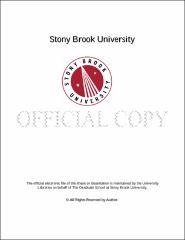| dc.identifier.uri | http://hdl.handle.net/11401/76096 | |
| dc.description.sponsorship | This work is sponsored by the Stony Brook University Graduate School in compliance with the requirements for completion of degree. | en_US |
| dc.format | Monograph | |
| dc.format.medium | Electronic Resource | en_US |
| dc.language.iso | en_US | |
| dc.publisher | The Graduate School, Stony Brook University: Stony Brook, NY. | |
| dc.type | Thesis | |
| dcterms.abstract | Vitamin B<sub>12</sub> is an organic micronutrient in the ocean, and it is required for the growth of majority of phytoplankton. Because of the ultra-low concentrations of vitamin B<sub>12</sub> in the ocean and the lack of suitable analytical methods, the distribution, transport and biogeochemical cycling of vitamin B<sub>12</sub> in marine ecosystem have not been essentially documented. In this thesis, vitamin B<sub>12</sub> distribution and reaction patterns in water column and marine sediments were preliminary studied by using newly developed immunoassay methods. Two new sensitive and specific enzyme-linked immunosorbent assay (ELISA) methods have been developed and compared in Chapter two, based on indirect competitive immunoassay format, to measure the concentration of vitamin B<sub>12</sub> in coastal seawater and sediment porewater. Rabbit anti-vitamin B<sub>12</sub> polyclonal antibody was used to specific recognize vitamin B<sub>12</sub> from samples, horseradish peroxidase (HRP) was used as a labeling enzyme and tetramethylbenzidine (TMB) was as enzyme substrate. All the immunoassay conditions were optimized. Under the optimal conditions, the absorbance signal was inversely proportional to the concentration of vitamin B<sub>12</sub> in samples. The dynamic range for B<sub>12</sub> was 0.1 - 100 ng/ml with a detection limit of 0.05 ng/ml (3&sigma). Coupled with C-18 column solid-phase extraction - preconcentration, the ELISA methods were readily applicable to measure B<sub>12</sub> in marine samples. Vitamin B<sub>12</sub> distribution patterns in Long Island Sound water column were studied in Chapter three. Results show that vitamin B<sub>12</sub> has a higher concentration in sediment porewater than in overlying seawater, and the B<sub>12</sub> concentration gradually increases with depth in water column because the phytoplankton consumption and benthic sources could influence the vertical patterns of B<sub>12</sub>. The distributions of B<sub>12</sub> in seawater also show a seasonal variation. Vitamin B<sub>12</sub> distributions in marine sediments were also revealed by ELISA measurement, a vitamin B<sub>12</sub> concentration maximum zone was observed for the first time at the depth of ~2 cm in the sediment. The concentration of B<sub>12</sub> at sediment surface is close to that in the bottom water, however it increases sharply just below the water-sediment interface and reaches maximum at the oxic-anoxic boundary. Beneath the maximum, B<sub>12</sub> concentration significantly decreases with depth, and reaches almost constant below 4 cm in sediment, suggesting that bacteria at or near the oxic-anoxic boundary may be involved in the generation of vitamin B<sub>12</sub>. The new B<sub>12</sub> profiles provide insight into the source, cycling and transport of vitamin B<sub>12</sub>. Adsorption-desorption behaviors of vitamin B<sub>12</sub> on sediment particles under various conditions were studied in order to elucidate the B<sub>12</sub> profiles and transport in sediments. It was found that in natural conditions over 99% vitamin B<sub>12</sub> was adsorbed on particles in marine sediments, and the adsorption was likely irreversible. The physical and chemical adsorption of B<sub>12</sub> on particles may dominate its distribution and transport in sediment and across sediment-water interface. | |
| dcterms.available | 2017-09-20T16:42:20Z | |
| dcterms.contributor | Aller, Robert | en_US |
| dcterms.contributor | Zhu, Qingzhi | en_US |
| dcterms.contributor | Aller, Josephine. | en_US |
| dcterms.creator | Liu, Meichen | |
| dcterms.dateAccepted | 2017-09-20T16:42:20Z | |
| dcterms.dateSubmitted | 2017-09-20T16:42:20Z | |
| dcterms.description | Department of Marine and Atmospheric Science. | en_US |
| dcterms.extent | 71 pg. | en_US |
| dcterms.format | Application/PDF | en_US |
| dcterms.format | Monograph | |
| dcterms.identifier | http://hdl.handle.net/11401/76096 | |
| dcterms.issued | 2013-12-01 | |
| dcterms.language | en_US | |
| dcterms.provenance | Made available in DSpace on 2017-09-20T16:42:20Z (GMT). No. of bitstreams: 1
Liu_grad.sunysb_0771M_11510.pdf: 826914 bytes, checksum: 4ed64398e5e16691e232a6140ea1548d (MD5)
Previous issue date: 1 | en |
| dcterms.publisher | The Graduate School, Stony Brook University: Stony Brook, NY. | |
| dcterms.subject | Chemical oceanography | |
| dcterms.subject | ELISA, marine sediment, vitamin B12 | |
| dcterms.title | Vitamin B12 distribution patterns in marine sediments revealed by a new ELISA method | |
| dcterms.type | Thesis | |

